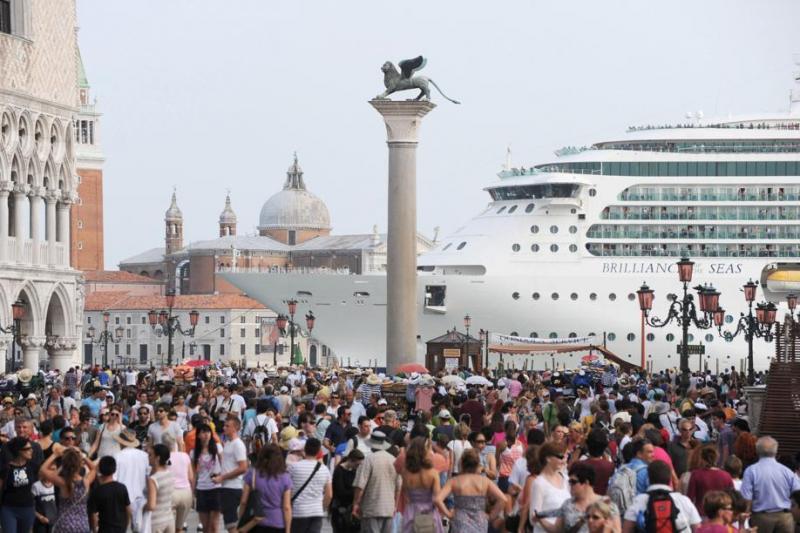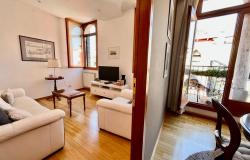How could you not love Venice! Many of us at ITALY Magazine have lived in or close to Venice, some of us still do. And it breaks our heart when we hear people saying they did not enjoy their visit, they felt like the city is "turning itself into Disneyland", they think the big ships crossing St Mark's Basin take the romance away and so on. This is why we want to help our readers to understand more about the problems the city is facing and offer the right tips to make sure they will enjoy this wonderful, unique, incredible city. We start with an article by Myra Robins, explaining why the Veneziani are protesting against the impact of Big Ships invading the lagoon.
The first time you visit Venice, they say, you should arrive by water for maximum impact. Maximum impact is a good way of putting it in more ways than one.
These days huge numbers of tourists – 1.8 million of them last year – arrive on cruise ships. They at least can’t see, as we can from the city itself, the visual impact their transport makes, dwarfing the dreaming profile of campanile, baroque domes and the forest of pepper pot chimneys and statues on palazzi roof tops. The cruise ships block the view, they displace water into the side canals, they disturb the ancient buildings to their very foundations, and they add a tacky backdrop of floating 15 storey white boxes totally at odds with the glories of Venetian architecture.

We’re all aware of the dangers Venice faces from the frequent flooding (acqua alta) at high tides, leaving residents and businesses alike having at best to block up their doorways to prevent water seeping in, and at worst to abandon ground floor living and move upstairs. (Even the thousand year-old tesserae of the mosaic floors of St Mark’s are now deteriorating as a result of water damage.) Venetians regularly go about their daily lives along wooden walkways constructed above flood level. These days the planks are left in piles along the alleyways: there’s no point storing them; they’re needed too often.
The effects of the tides are bad enough, but the dredging needed to allow the big ships to come across the Lagoon makes matters ten times worse. The Lagoon has a delicate ecosystem which the Venetians used when the city was constructed on millions of wooden posts driven into the sea bed. As in parts it is only 12 feet deep, huge quantities of mud need to be removed to make a channel down the Giudecca Canal for the cruisers. But the mud acts as a preservative: take it away and the wooden foundations rot, adding to the ever-increasing sinking of the city.
How has this been allowed to happen? In 1987 Venice was designated a UNESCO World Heritage Site, but contrary to what you might think, this label does very little to protect it. There are no additional funds, and the only action which can be taken is to report abuse of the city’s world heritage status to the head office in Paris.

In 2012 Venice City Council finally came up with an action plan, having consulted 250 public bodies, surprisingly not including the popular “No Grandi Navi” movement, whilst at the same time paying attention to the Venice Port Authority’s submission with its declared intention of developing Venice’s port. Clearly commercial considerations by far outweigh priorities of preservation. Since 1997 €141 million has been spent by the V.P.A.on modernising the port, and the company which manages Marco Polo airport has also contributed financially, given that most cruise passengers arrive or depart by air. Unfortunately the city council has no say in how the port is managed: it is typical of Italian bureaucracy that the delineation of responsibilities means that action cannot be taken because the power lies elsewhere.
There are constant protests. The photographer Gianni Berengo Gardin has made his own personal protest with a collection of black and white photos of what he calls the monster ships. The images of gigantic cruisers juxtaposed against the backdrop of St Mark’s, or with tourists and Venetians alike passing giant ships without a second glance, pose immediate questions.
“With four ships a day everyone is used to them,” he points out with a shrug.
Why does he take these photos? “Venice now seems out of scale, transformed into Toytown by these monsters. There is no difference between the real thing and its totally artificial counterpart in the U.S.A.,” he says.

The No Big Ships campaigners have lined the Giudecca with publicity banners letting passengers know how fed up they are. Their leader, Silvio Testa, points out that on one day alone 35,000 tourists disembarked in Venice. But do these tourists at least benefit the economy? No they do not. If they’ve already paid for all meals they’re not likely to eat in a local trattoria. At most they’ll buy a mask and a gelato and go back on board.
Are there any current proposals which could save Venice? An alternative port near the petrochemical plants would be better for the future of the city, but it would deprive passengers of their wonderful views from the decks, so that’s unlikely to happen. Another sensible suggestion is a new port near the Lido with passengers coming into Venice by hydrofoil. However, with the current state of Italy’s economy this is too costly to consider.
The lagoon floodwater barriers begun in 2003 and not due to be completed until 2016 will make a difference, but they are absorbing most of the city’s revenues, leaving only about €40 million a year for Venice instead of the €592 million available in 2002.
But Venice’s problems extend beyond the cruise ships. Tourism itself needs to be addressed. Following the example of Rome, it was agreed that Venice should levy a tourist tax. It has never happened because they couldn’t agree on how the proceeds should be spent. Equally, there has long been talk of limiting the numbers entering Venice each day, which would certainly be justified on grounds of safety as well as pressure on the environment, but again nothing is ever done despite the fact that 6.4 million tourists per annum could bring in over €100 million a year in increased revenue for the city.
St Mark’s Square is always packed with people because the basilica will not consider timed ticket entry, so long queues have become a daily nuisance.
There’s even a conflict of interest over the pigeons. Known to Venetians as flying rats, they are vermin and need to be controlled (there are regular early morning culls) but the purveyors of pigeon food pay high prices for their licences, and the city doesn’t want to be deprived of the revenue.
I’m not the first person to say that Venice is running the risk of turning itself into Disneyland. The irony is that if that were really the case, it would probably be better managed.
To know more about the protest visit http://www.nograndinavi.it














